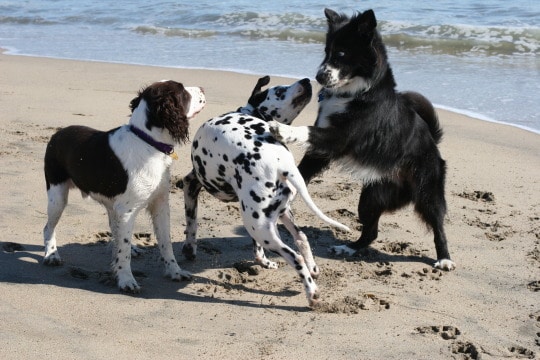Your dog and group dynamics — keeping an eye on things…

When your dog is in a group of other dogs it is important that you are aware of body language and group dynamics. Things can change quickly.
Here is an example to illustrate my point. While out with Ziggy a couple of days ago, enjoying the river and having fun playing with a young, very good natured Rottweiler bitch, other dogs began to arrive on the scene.
From just two dogs playing, it quickly became five or six. All these dogs were getting along pretty well — playing nicely. The young Rottie was getting on well with the growing gang. Then, another dog joined the fun. This was a young, fairly small, Poodle X. This dog was intact (not castrated) — an important point.
The group dynamic changed quickly. The usual pleasantries seemed to be observed — sniffing of rear ends, etc. The new arrival appeared to be a little pushy and in the face of the other dogs. This wasn’t that obvious to the untrained eye — but, it was there.
The happy Rottie suddenly turned on the smaller male dog, giving chase and snapping at it’s back. It didn’t bite the other dog but, may have done. Of course the owner of the smaller dog was screaming as the Rottie was got under control. The Rottie quickly calmed down. The other dog was removed by the angry owner — offended by the Rottie ‘attacking’ her dog.
So, what caused the fun session to turn sour so quickly?
The ‘guilty’ party here was the Poodle X. He was trying to exert his dominance over the other dogs — not unusual behaviour for an intact male. This, often, does not always lead to problems. However, in this case, the larger Rottie was not impressed and was certainly not going to defer to the Poodle X — net result is that the Rottie turned on the offending dog and asserted her authority. A natural canine response. This does not mean that the Rottie is an aggressive or ‘bad’ dog — she is, simply, responding to the Poodle’s challenge.
Could this outcome have been foreseen and avoided. The simple answer is yes.
By observing the dogs/s it is possible to spot the warning signs. In this case, some of the dogs, including the Rottie, were visibly displaying that they were uncomfortable with the attentions of the Poodle.
Two things should have been done here: firstly the Poodle’s owner should have moved their dog on or put it on the lead. The Rottie’s owner should have done similar or, at least, put her dog on the lead. I know — this doesn’t seem fair. However, it is better to take your dog out of a situation that may result in it having to respond as the Rottie did. Dogs, if exposed to this sort of situation a few times, can develop a standard response — in this case, showing aggression to other dogs.
I would also recommend, on the advice from your vet, castrating male dogs — this can help prevent these types of problems.
The take home message here, is to keep an eye on your dog and, on the other dogs it may be interacting with. The old adage ‘prevention is better than the cure’ holds true here.
